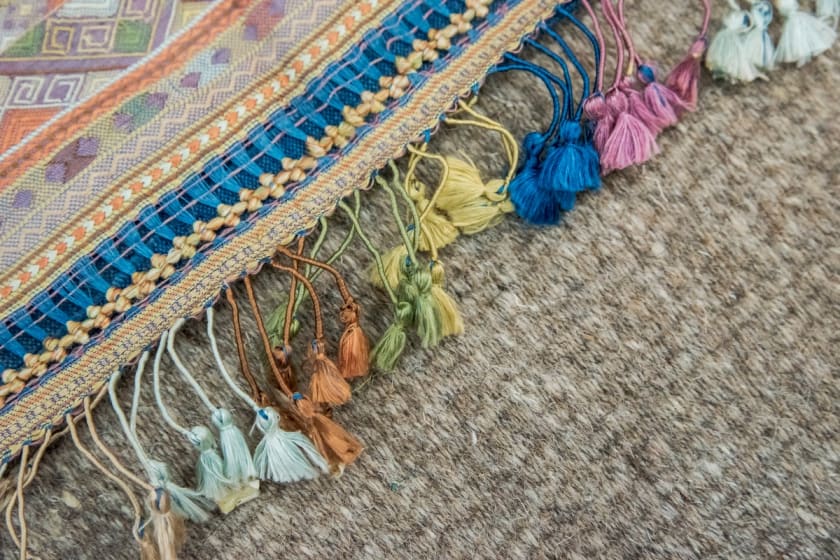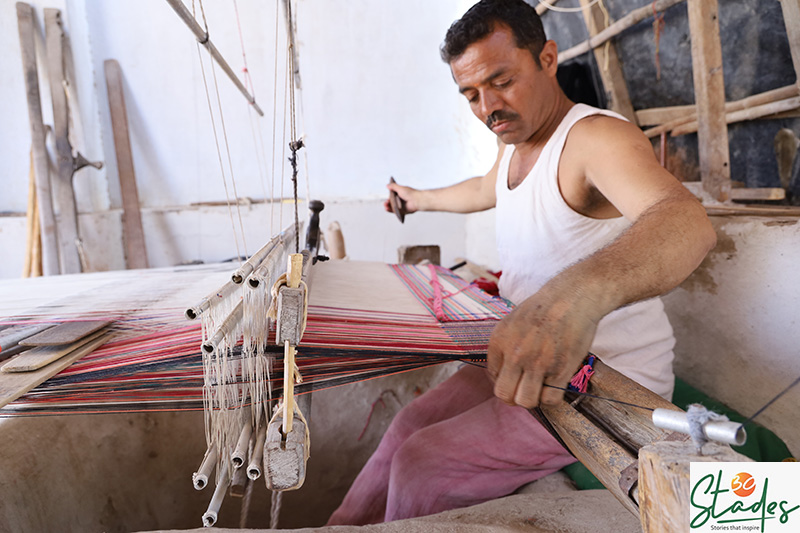Dhabla: Everything You Need To Know About It



Dhabla - An Overview of Kutch Weave.
Dhabla is a Rajasthani-style Kutch weaving that has been around for centuries. The Vankar people arrived in the Kutch region from Rajasthan. They were also known as the Meghwals and they often went to Kutch to see their relatives there. The Rabaris, a different ethnic group, raised sheep and embroidered exclusively, but they lacked weaving expertise. Due to increased commerce, the Vankars relocated to Kutch and established themselves there. The Vankar people of Rajasthan and Kutch were the first to weave the dhabla weave, which originated in the region's hot climate. In the quest of the saint Shri Ram Dev Pirji, the Meghwals made their way to Kutch. Traders from these groups would often visit Kutch. Kutch's first settlers were the Rabari and Ahir populations, who raised sheep. Although the Ahir and Rabari cultures also manufactured their own Dhabla, they lacked the weaving ability.
Introduction
Dhabla, the graceful weaving of the deserts, has its origins in the Kutch area of India. Natural colours were used to produce the traditional Dhabla, 100 inches in length. The Rabari women would meticulously weave a Dhabla- a conventional blanket worn by the males of the hamlet- until it was finished. The Dhabla was historically constructed of single and two-ply wool and was rather heavy. Due to its delicate patterning, raindrops could not penetrate the cloth. Males also wore the Dhabla to keep them comfortable throughout the day.
Traditional Dhabla art has developed throughout time as a result of cultural influences. The Dhabla cloth is produced by the Vankar people in the Indian state of Gujarat. On the other hand, the Ahir population does not weave and primarily relies on agriculture and livestock. Despite their modest population, the Meghwals are well-known for their bhojsari embroidery design. The Meghwal people are responsible for creating kashida pattu and Baladi checks.
Dhabla weaving has an ancient legacy.

The Dhabla weave is a traditional Indian handicraft that originates in the Indian state of Kutch.
- Dhabla is a one-of-a-kind, brightly coloured cloth utilised by the Rabaris in ancient times.
- Traditionally, the Dhabla would be woven in two sections, one of which was 26 inches broad and the other 100 inches in length.
- The Rabari women wore the Dhabla throughout the day, and they were skillful enough to create beautiful designs and motifs.
- In ancient times, the loom width was limited, and the pickers used hand shuttles to choose the threads for weaving on it. The weaving procedure was very time-consuming, and the Dhabla itself was pretty heavy.
- In addition, the Dhabla blankets were pretty huge, ranging between 80 and 100 inches in total length.
- Rabari women weave Dhabla in the scorching sun, frequently accompanied by goats and lambs, to keep cool during the summer months.
- It used to be that the local sheep's wool was harvested twice a year, once before the rains and once during the winter months.
- As the skill developed in popularity, the demand for wool rose, and the quality of the wool available in the area declined.
- Dhabla shawls, on the other hand, were manufactured for the wealthy, and the poor sported them in the countryside.
Dhabla Weave's Raw Supplies.
The Dhabla weave is made entirely with wool, which is an absolute need. It was easier to work with wool than a lighter fabric like cotton in Rajasthan and Kutch during the winter months because wool was easily available. Using goat and sheep wool, the Dhabla was created, and the weaving process was completed with the help of a pit shuttle loom and a basic up and down method. Traditionally to the Rabaris, they would collect wool from the local sheep twice a year: first before the rainy season and again near the conclusion of the winter season. Previously, the amount of wool produced was just adequate to meet the needs of the home market. However, as the skill grew in popularity, the demand for wool rose, and the weavers finally realised that they needed to get yarn from other sources. However, there were no unique qualities in the local wool.
The Dhabla is a traditional handloom cloth from Gujarat, India, produced in Kutch. It is woven in two parts, each measuring around 26 inches across, created by skilled craftspeople. The cloth is stitched with great care by the women of the village, who use only the finest threads. Dhabla was typically fashioned from single and two-ply yarn and was quite heavy. Because the weave is so tight, raindrops could not penetrate the fabric's internal structure. The dhabla was used by both men and women to keep warm and comfortable in cold weather.
To begin with, the Dhabla was created from shawls and was intended for the Rabari people in north-western Gujarat. As the demand for the Dhabla expanded, the Rabari started producing sarees and stoles for the international market due to their success. In addition to goat and sheep wool, the peasants employed a variety of other fibres in their weaving.
There are presently four basic types of yarns that the weavers use:
- One hundred percent of the time Ludhiana, India, is the source of merino wool, purchased at the start of November.
- Its usage raises the cost of the finished product by an extravagant amount on the local market.
- Artificial wool is a somewhat inexpensive option.
- Desi wool is a kind of wool produced by native sheep in Kutch and Rajasthan.
- Silk fabric is utilised, including several types of silk, such as tussar, sourced via Bihar.
Dhabla weave dye technique.

Black, white, and brownish-brown wool were the most common neutral hues utilised in the industry's early days. Eventually, they added colour to their sheep's wool when people honed their dying skills. Spin, Dye, warp, pattern, and weaving are all part of the process of making a Bhujodi item. To carry out any of these procedures, you'll need specialised devices that are both fundamental and have been around for ages. Organic dyes like blues, lac, and other natural materials have had a renaissance in textile dying in recent years due to a rise in interest in natural colours.
- Dyed wool has seen an uptick in popularity in recent years due to the growing popularity of coloured fabrics.
- Textile and other items have seen a comeback in demand for dyes made from natural sources such as indigo, lac, and other plant-based materials.
- The artists use yarn in hanks, which are hand-coloured in small batches by the weavers themselves whenever they perform their coloration.
- Wool is now dyed using plant pigments rather than animal ones. All-natural ingredients, such as onion scraps, lac, and madder, are used in the dyeing process of vegetable colours.
Spinning and Weaving of the Rabari shawl – Step-by-step guide
The traditional, time-consuming, and expensive method of making a Rabari shawl is as follows:
- The weaver's family may spin the wool. The women of Rabari communities usually do so.
- The weavers proceed to weave the fabric. The old-fashioned pit looms could only weave one-half of a shawl due to their narrow width.
- Consequently, the first two halves are sewed together.
- After that, they are stitched together in a unique yet attractive way, using a fish stitch.
- The woven fabric is sent to the dyehouses.
- It is then delivered to the Rabari women, who complete the appearance with their hand-stitched embroidery in various bright, complicated patterns and colours.
- Herders were historically responsible for shaving their animals until a few years ago.
- Once or twice a year, shearers from districts close to the Rajasthani border go from hamlets to villages to shear the sheep.
Dhabla - Styling portfolio
- Designs & Patterns – Conventional patterns based on the artisans' daily routines, such as geometrical motifs, are part of their standard toolkit. The weaver can only generate pointed motifs utilising the extra weft patterning approach that they have designed. There is no way to make precise curvilinear patterns using this tool. Designers used to prefer simple layouts in the past. However, general jaal and designs based on basic geometric patterns are the most popular trends. Also standard are stripes that run in the opposite direction as the warp.
- Colour schemes - White, black, red, and brownish were the only natural dye colours in the original dhabla's colour scheme. The rest was quite complex. Weft patterning in shades of black and burgundy appeared on the sleeves and hem of this white dress. Woven warp-wise, black and maroon borders were occasionally used. Few patterns could be seen in the vast majority of the time
Conclusion
The current situation is one of responding to local market needs. It has become more common for the Vankars of Kutch to create textiles for the urban market in more significant numbers than ever before. This strategy is used throughout the weaving process because of its adaptability. There is no need for ordering forms or written instructions for weavers who receive orders verbally. The only metal things in the room are a bucket, scissors, and a few pegs in a woodworking loom. Local water and sunlight and the expertise of the weavers' hands allow them to pursue their goals and provide for their families. To get the most up-to-date picture of Dhabla's urbanisation, Fashinza, a B2B clothing manufacturing platform, is your best option.



















